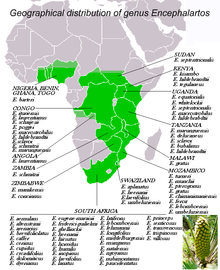| Encephalartos | |
|---|---|

| |
| a) habit of female E. hildebrandtii b) seed cone of the same, and c) seed cone of E. villosus | |
| Scientific classification | |
| Kingdom: | Plantae |
| Clade: | Tracheophytes |
| Clade: | Gymnospermae |
| Division: | Cycadophyta |
| Class: | Cycadopsida |
| Order: | Cycadales |
| Family: | Zamiaceae |
| Subfamily: | Encephalartoideae |
| Tribe: | Encephalarteae |
| Subtribe: | Encephalartinae Benth. & Hook.f. |
| Genus: | Encephalartos Lehm. |
| Type species | |
| Encephalartos friderici-guilielmi | |

| |
| geographical distribution of genus | |
Encephalartos is a genus of cycad native to Africa. Several species of Encephalartos are commonly referred to as bread trees,[2] bread palms[3] or kaffir bread,[4] since a bread-like starchy food can be prepared from the centre of the stem. The genus name is derived from the Greek words en (within), kephalē (head), and artos (bread), referring to the use of the pith to make food. They are, in evolutionary terms, some of the most primitive living gymnosperms.
All the species are endangered, some critically, due to their exploitation by collectors and traditional medicine gatherers.[5] The whole genus is listed under CITES Appendix I which prohibits international trade in specimens of these species except for certain non-commercial motives, such as scientific research.
- ^ "Appendices | CITES". cites.org. Retrieved 2022-01-14.
- ^ "Bread tree, n. phr". Dictionary of South African English. Dictionary Unit for South African English. 2019. Retrieved 27 January 2020.
- ^ "Bread palm, n. phr". Dictionary of South African English. Dictionary Unit for South African English. 2019. Retrieved 27 January 2020.
- ^ "Kaffir-bread, n." Dictionary of South African English. Dictionary Unit for South African English. 2019. Retrieved 27 January 2020.
- ^ Schmidt, Ernst; Lötter, Mervyn; McCleland, Warren (2002). Trees and shrubs of Mpumalanga and Kruger National Park. Johannesburg: Jacana. p. 46. ISBN 9781919777306.